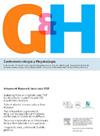Hipertensión portal: recomendaciones de diagnóstico y tratamiento. Documento de consenso de la Asociación Española para el Estudio del Hígado (AEEH) y el Centro para la Investigación Biomédica en Red de Enfermedades Hepáticas y Digestivas (CIBERehd)
IF 2.2
4区 医学
Q3 GASTROENTEROLOGY & HEPATOLOGY
引用次数: 0
Abstract
Portal hypertension is a hemodynamic abnormality that complicates the course of cirrhosis, as well as other diseases that affect the portal venous circulation. The development of portal hypertension compromises prognosis, especially when it rises above a certain threshold known as clinically significant portal hypertension (CSPH). In the consensus conference on Portal Hypertension promoted by the Spanish Association for the Study of the Liver and the Hepatic and Digestive diseases area of the Biomedical Research Networking Center (CIBERehd), different aspects of the diagnosis and treatment of portal hypertension caused by cirrhosis or other diseases were discussed. The outcome of this discussion was a set of recommendations that achieved varying degrees of consensus among panelists and are reflected in this consensus document. The six areas under discussion were: the relevance of CSPH and the non-invasive methods used for its diagnosis and that of cirrhosis, the prevention of the first episode of decompensation and its recurrence, the treatment of acute variceal bleeding and other complications of portal hypertension, the indications for the use of TIPS, and finally, the diagnosis and treatment of liver vascular diseases.
门静脉高压:诊断和治疗的建议。由西班牙肝脏研究协会(AEEH)和肝脏和消化疾病生物医学研究网络中心(CIBERehd)赞助的共识文件。
门脉高压是一种血液动力学异常,它使肝硬化和其他影响门静脉循环的疾病的病程复杂化。门脉高压的发展影响预后,特别是当它超过一定阈值时,称为临床显著门脉高压(CSPH)。在西班牙肝脏研究协会和生物医学研究网络中心(CIBERehd)肝脏和消化疾病领域推动的门脉高压共识会议上,讨论了肝硬化或其他疾病引起的门脉高压的诊断和治疗的不同方面。这次讨论的结果是一组建议,这些建议在小组成员之间取得了不同程度的协商一致意见,并反映在本协商一致文件中。讨论的六个方面是:CSPH的相关性及其与肝硬化的无创诊断方法,预防首次失代偿及其复发,治疗急性静脉曲张出血和门静脉高压的其他并发症,TIPS的适应症,最后是肝血管疾病的诊断和治疗。
本文章由计算机程序翻译,如有差异,请以英文原文为准。
求助全文
约1分钟内获得全文
求助全文
来源期刊

Gastroenterologia y hepatologia
GASTROENTEROLOGY & HEPATOLOGY-
CiteScore
1.50
自引率
10.50%
发文量
147
审稿时长
48 days
期刊介绍:
Gastroenterology and Hepatology is the first journal to cover the latest advances in pathology of the gastrointestinal tract, liver, pancreas, and bile ducts, making it an indispensable tool for gastroenterologists, hepatologists, internists and general practitioners.
 求助内容:
求助内容: 应助结果提醒方式:
应助结果提醒方式:


